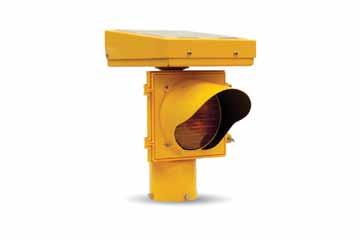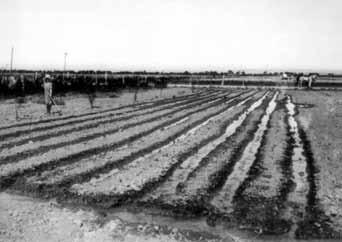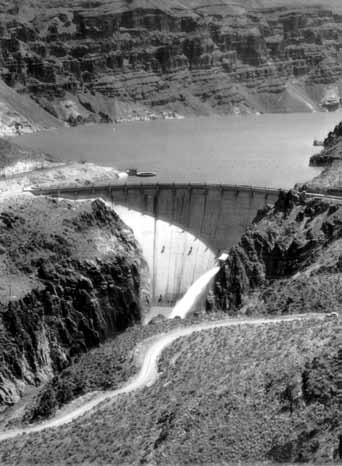
8 minute read
The Bureau of Reclamation: 110 years providing water and electricity to the West
Brit Allan Storey
Senior Historian Bureau of Reclamation Littleton, Colorado
Advertisement
he American West is generally arid, and water was a major concern of settlers who watched the gush of spring and early summer runoff flow away from their towns and crops. Settlers developed simple and inexpensive water projects, but, as population increased, demands for federal water storage projects grew. Westerners soon understood they generally lacked access to sufficient money and engineering skill for more complex water projects, and they hoped to find those resources in the national government. Those clamoring for “reclamation projects” believed that irrigation would “reclaim” or “subjugate” western arid lands for human use and make homes for American families. Before 1900, the United States Congress had already invested heavily in America’s infrastructure by subsidizing roads, river navigation, harbors, canals, and railroads. Western boosters clamored for extension of that tradition of government subsidies to irrigation to support expansion of western settlement. In 1901, “reclamation” gained an important supporter when Theodore Roosevelt became President. He supported the “reclamation” movement because of his personal experience in the West. President Roosevelt signed the Reclamation Act on June 17, 1902. The original concept was that water users would repay the costs of construction of a project over a 10-year period and would pay all annual maintenance costs.
In July 1902, the Secretary of the Interior established the United States Reclamation Service (USRS) within the U.S. Geological Survey’s (USGS) Division of Hydrography. The Reclamation Act required that Reclamation comply with numerous and often widely varying state and territorial legal codes. Subsequent development and ratification over the years of numerous interstate compacts governing the sharing of stream flows between states, as well as several international treaties governing the sharing of streams by the United States with Mexico or Canada, made Reclamation’s responsibilities to comply with U.S., state, and territorial water law very complex.
In its early years, the Reclamation Service relied heavily on the USGS Division of Hydrography’s previous studies of potential projects in the West so that between 1903 and 1906, about 25 projects were authorized throughout the West. Reclamation funding originally came from sales of public lands and Texas had no federal lands. As a result, Texas was not one of the original “reclamation” states, but it convinced the Congress to make it a reclamation state in 1906.
In 1907 the Secretary of the Interior separated the USRS from the USGS and made it an independent bureau within the Department of the Interior. The Congress and Executive Branch were then just learning that Congress’s initial 10-year repayment period was inadequate, and Congress eventually increased the repayment period to 20 years, then to 40 years, and ultimately to an indefinite period based on “ability to pay.” Other issues also appeared: soil science problems related both to construction
Gibson Dam in August 1929. Gibson was the first dam completely designed using the Trial Load Method which was refined within Reclamation for a decade and had previously been used to assure the strength of designs after completion.
and to the ability of soils to grow crops; economic viability of projects (repayment potential) including climatic limitations on the value of crops; waterlogging of irrigated lands on projects, resulting in the need for expensive drainage projects; and the need for practical farming experience for people successfully to take up project farms. Many projects fell far behind on their repayment schedules, and settlers vocally expressed their discontent to the Congress.
Learning from the problems, Congress and the Department of the Interior made substantial changes beginning as the Secretary changed the name of the USRS to Bureau of Reclamation in 1923. Then, in 1924, the Fact Finder’s Act began major adjustments to the basic Reclamation program. Elwood Mead was appointed Commissioner of Reclamation in 1924 as the reshaping of Reclamation continued.
A signal of the changes came in 1928, for instance, when the Congress passed the Boulder Canyon Project Act ratifying the Colorado River Compact and authorizing the Boulder Canyon Project (Hoover Dam and the All-American Canal). For the first time, large appropriations began to flow to Reclamation directly from the general funds of the United States instead of from public land sales. Congress specified that hydropower revenues would repay the project, and historians now recognize the Congress tacitly admitted that construction costs on many projects could not be repaid without hydropower revenues. Subsequently, during the Great Depression, Congress authorized almost 40 projects for the dual purposes of promoting infrastructure development and providing public works jobs. Among these projects were the beginnings of the Central Valley Project in California, the Colorado-Big Thompson Project in Colorado, and the Columbia Basin Project in Washington. Those three projects, combined with the older Minidoka and Boulder Canyon projects, irrigate about fifty percent of Reclamation acreage. Ultimately, of Reclamation’s more than 180 projects, about 70 received authorization before World War II. Authorization for the remainder, during and after World War II, occurred in many authorizations, including the PickSloan Missouri Basin Program (1944), the Colorado River Storage Project (1956), and the third power plant at Grand Coulee Dam (1966). Reclamation’s last really big construction authorization occurred in 1968 when Congress approved the Colorado River Basin Project Act which included, among others, the Central Arizona Project, the Dolores Project, the Animas-La Plata Project, and parts of the Central Utah Project.
During the 1960s, Reclamation’s work began to change substantially as public awareness changed. Reclamation began building projects primarily for urban water supply, and Americans became increasingly concerned and proprietary about the use and protection of natural resources. This change resulted, in part, from improved communication and, in part, from improved science

Elegant, economical and environmentally friendly.
24-Hour Warning Beacons
Solar-powered, wireless and easy to install.
Pedestrian-Activated Crosswalk Beacons
JSF Technologies 1.800.990.2454 +1.250.544.1640 www.jsftech.com

Henry T. Cowling photographed this irrigation scene on the Sun River Project in September 1913. Irrigating crops in the arid West was Reclamation’s primary early mission. This water nourished strawberries on J. K. Hill’s farm near Simms, Montana.
resulting in clearer understanding of the complex interactions of the communities of nature with western water development issues. Americans were beginning better to understand issues about the West and to consider the public lands and public works of the West as “mine” or “ours”— even though they lived elsewhere. These new public concerns shifted Reclamation priorities, and over 10 percent of Reclamation’s FY2013 budget, for instance, is programmed for various environmental restoration and improvement projects in the West.
Reclamation’s number one priority is always to deliver water, but that priority is often affected by the available water supply and the constraints imposed by various laws, regulations, and court rulings. During an average water year, more than 180 Reclamation projects deliver agricultural water that irrigates about 10,000,000 acres of land in the arid West—about one-third of the irrigated acreage in the West. Farmers on Reclamation projects produce a significant percentage of the value of all crops in the United States, including about 60 percent of vegetables and 25 percent of the fruit and nut crops. Reclamation also delivers water used by about onethird of the people in the West. Reclamation’s second major product delivered to the American public is hydroelectricity. Although the earliest hydroelectric plants on Reclamation projects went into operation in 1908 and 1909, it was only during the 1930s that generation of hydroelectric power became a principal benefit of Reclamation projects. Reclamation built the large hydroelectric power plants at Hoover, Grand Coulee and Shasta dams. Hydroelectric revenues have subsequently proven an important source for funding repayment of Reclamation project costs. The water available in a system determines how much power it is possible to generate; in 1993, for example, Reclamation had 56 power plants online and generated 34.7 billion kilowatt hours of electricity. In 1999, revenues from Grand Coulee hydroelectric generation alone equaled about two-thirds of Reclamation’s entire appropriated budget.
While Reclamation’s mission “...is to manage, develop, and protect water and related resources in an environmentally and economically sound manner in the interest of the American public,” many benefits of Reclamation projects do not come directly from Reclamation’s primary responsibilities—providing water and hydropower. Water bodies in the West naturally attracted recreationists from the earliest days of projects, and today extensive and varied recreation activities occur on projects. Operation of Reclamation impoundments provides flood control and drought relief benefits. The U.S. State Department regularly uses Reclamation’s technical expertise in international activities and in training foreign engineers. In addition, agencies from around the U.S. regularly find Reclamation’s experience useful in developing water conservation, supplemental supply, and water augmentation programs.

Early construction methods used cheap labor and expensive materials. Walter J. Lubken, a Reclamation photographer, lined up these mules for a portrait. They were used in construction work on the Sun River Project, Montana, in June 1910. Owyhee Dam in May 1949. Notice the morning glory spillway about to be reached by reservoir waters. Several construction techniques were tested at Owyhee before use during Hoover Dam construction. At 417 feet in height, Owyhee was the highest dam in the world until Hoover Dam which topped out at 726 feet.

Because of continuing initiatives begun in the late 1980s and early 1990s, Reclamation’s staffing level has trended downward and the staffing mix has changed in recent years. In 2010, for instance, Reclamation staff was about 29 percent smaller than in 1993 and includes a much higher percentage of computer and non-engineering specialists. Many projects are actually operated and maintained by the water users. As Reclamation enters into additional partnerships with beneficiaries of the water and electricity produced on its projects and shifts increasingly away from construction development projects toward water management activities, Reclamation’s staffing levels are expected to shrink even further in the twenty-first century.
Britt Allan Storey can be reached at BStorey@usbr.gov.










